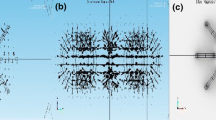Abstract
In order to maintain equilibrium in small or large tokamaks poloidal field coils are utilized, since the function of the poloidal magnetic field is a complex function of current density and the position of the coils, a change in any of the parameters can have a strong effect in the confinement and the magnetohydrodynamic parameters. On the other hand, considering the continuity of the current and the position of the coils, the space being searched is so big that taking all possible conditions into account becomes practically impossible. So a method should be utilized that is able to optimize the position and current of the coils without searching the whole space. This paper seeks to find a new method of deriving the plasma parameter in which a combination of the two methods of neural network and Particles Swarm Optimization is used in order to optimize the position and current of poloidal field coils in Damavand tokamak. Since in the employed methods no special topology is applied, it can be readily used to study any other tokamak.





Similar content being viewed by others
References
K. Toi, T. Takeda, Optimum design of control coils in a Tokamak device by nonlinear optimization. Jpn. J. Appl. Phys. 16, 325–334 (1977)
T. Kobayashi, K. Tani, S. Tamura, Determination of optimum positions of the poloidal field coils of a large tokamak. Jpn. J. Appl. Phys. 17, 2139–2146 (1978)
V.D. Shafranov, L.E. Zakharov, Use of the virtual-casing principle in calculating the containing magnetic field in toroidal plasma systems. Nucl. Fusion 12, 561–568 (1972)
K. Lackner, Computation of ideal MHD equilibria. Comput. Phys. Commun. 12, 33–44 (1976)
D.J. Strickler, N. Pomphrey, S. CJardin, Equilibrium Shape Control in CIT PF Design. In: Proceedings, IEEE Thirteenth Symposium on (1989)
R.H. Bulmer, Tokamak physics experiment poloidal field design. Fusion. Eng. (1993)
R. Amrollahi, H. Minoo, S. Khorasani, F. Dini, Optimization of Tokamak Poloidal Field Configuration by Genetic Algorithms. In: Proceedings of 18th International Atomic Energy Agency Fusion Energy Conference (on CD-ROM), Sorrento (2000)
Z.L. An, X.P. Liu, B. Wu, X.J. Zha, Optimization of positions and currents of tokamak poloidal field coils using genetic algorithms. Fusion. Sci. Technol. 50(4), 561–568 (2006)
F. Dini, S. Khorasani, MHD equilibrium and kink stability in Damavand tokamak. J. Fusion Energ. 28(3), 282–289 (2009)
M. Ariola, A. Pironti, Magnetic Control of Tokamak Plasmas (Springer, Berlin, 2008)
M.T. Hagan, H.B. Demuth, M.H. Beale, Neural Network Design (PWS, Boston, 1995)
N. Nedjah, L.M. Mourella, Swarm Intelligent Systems (Springer, Berlin, 2006)
R.L. Haupt, S.E. Haupt, Practical Genetic Algorithms (Wiley, London, 2004)
J. Wesson, Tokamak (Clarendon Press, Oxford, 1989)
Author information
Authors and Affiliations
Corresponding author
Rights and permissions
About this article
Cite this article
Mohammadi, M., Dini, F. & Amrollahi, R. Optimization of Damavand Tokamak Poloidal Field Coils Positions and Currents with PSO Algorithm. J Fusion Energ 31, 170–174 (2012). https://doi.org/10.1007/s10894-011-9448-6
Published:
Issue Date:
DOI: https://doi.org/10.1007/s10894-011-9448-6




